Pre-combat history |
Table of Contents |
Brittany Campaign |
COMBAT COMMAND A
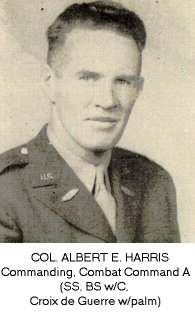 To
most men in Combat Command A the most important highlight in their European
Campaign was the action encountered at LANDROFF and in the HAN-SUR-NIED
areas in November 1944, when gains were measured in yards and the miserable
weather conditions made even the most optimistic soldiers wonder if the
war would ever end in their time.
To
most men in Combat Command A the most important highlight in their European
Campaign was the action encountered at LANDROFF and in the HAN-SUR-NIED
areas in November 1944, when gains were measured in yards and the miserable
weather conditions made even the most optimistic soldiers wonder if the
war would ever end in their time.
The Combat Command has no organic troops with the exception of a Headquarters Company. Composition of troops under its command were made and changed as the occasion demanded it, the only consistent member being Battery A, 777th AAA Battalion.
Past commanders of Combat Command A have been Brigadier General James Taylor, Colonel Harry F. Hanson, and Colonel John L. Hines.
COMBAT COMMAND B
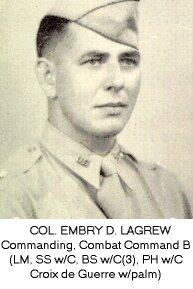 Combat
Command B fought its toughest battles at FORET DE GREMECEY in the SEILLE
River campaign, and at WARDIN and ARLONCOURT in the ARDENNES. Both
Combat Commands found the full meaning of exploitation during the first
and the last month of their action as they swept through first BRITTANY
and then GERMANY at a speed that belied the near-perfect setup of their
armored columns and Combat Teams.
Combat
Command B fought its toughest battles at FORET DE GREMECEY in the SEILLE
River campaign, and at WARDIN and ARLONCOURT in the ARDENNES. Both
Combat Commands found the full meaning of exploitation during the first
and the last month of their action as they swept through first BRITTANY
and then GERMANY at a speed that belied the near-perfect setup of their
armored columns and Combat Teams.
As in the case of Combat Command A, Combat Command B has its headquarters staff and its Headquarters Company, with composition of the command changing in accordance with the mission at hand. Battery B, 777th AAA Battalion was an almost permanent attachment to the headquarters.
Other commanders of Combat Command B were Brigadier General (then Colonel)
George W. Read, Jr., and Colonel Harry F. Hanson, who was in command until
18 April 1945.
RESERVE COMMAND
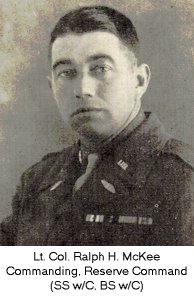 Throughout
most of the Division's action, Reserve Command was used primarily
to control all combat troops temporarily held in Division reserve, both
those assigned and those placed in Reserve from front line service for
rest and refitting. Although Reserve Command did not lack in offensive
action, it was set up to carry out defensive missions which normally did
not require the complete command set-up provided for in
Throughout
most of the Division's action, Reserve Command was used primarily
to control all combat troops temporarily held in Division reserve, both
those assigned and those placed in Reserve from front line service for
rest and refitting. Although Reserve Command did not lack in offensive
action, it was set up to carry out defensive missions which normally did
not require the complete command set-up provided for in
a combat command headquarters.
The Command was composed of a staff section with a small detachment of men, considerably less than a company. Reserve Command's big fight was at ZEITZ, and, as with the other commands, in the BASTOGNE battle.
Former commanders of Reserve Command were Colonel Harry F. Hanson,
Colonel Albert E. Harris, and Lt. Col. Embry D. Lagrew, who was in command
until 18 April 1945.
DIVISION ARTILLERY
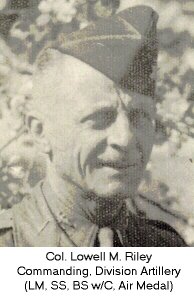 The
6th Armored Division Artillery consists of three organic 105mm self-propelled
howitzer battalions: the 128th, 212th, and 231st Armored Field Artillery
Battalions. The "Divarty" headquarters is supplemented by a Headquarters
Battery. Additional artillery battalions have been attached to "Divarty"
for special operations.
The
6th Armored Division Artillery consists of three organic 105mm self-propelled
howitzer battalions: the 128th, 212th, and 231st Armored Field Artillery
Battalions. The "Divarty" headquarters is supplemented by a Headquarters
Battery. Additional artillery battalions have been attached to "Divarty"
for special operations.
The Division attributes the greater part of its success in breaking up the many strong counter-attacks in the ARDENNES to the terrific barrages laid down by the artillery battalions that enabled our troops to push the Germans back to Germany.
Armored artillery is designed to move and shoot fast. Giving close support
to speeding tank and infantry columns, the battalions can roll off the
road into firing positions, with fire direction centers operating, in less
than ten minutes. The fluid, intelligent use of Divarty has been
an outstanding feature of the Division's success.
DIVISION HEADQUARTERS
Forward Echelon is the tactical headquarters of the Commanding General, the General Staff and those directly concerned with the conduct of the fighting. In the Rear Echelon are the administrative offices which maintain the vast amount of records and reports.
Closely behind the fighting elements move the halftracks, trucks and peeps of the Forward Echelon. Into this headquarters flow orders from higher headquarters, reports on the progress of the fighting, a mass of information concerning the enemy, reports of the division's strength in personnel and materiel and the availability of supplies. This information is correlated to form the basis for the Commanding General's plan of action. Here the decisions are made, and from this headquarters the orders covering all phases of the operation go out by radio, wire, liaison officer and messenger.
To speed communication with the fighting elements and enable the Division Commander to reach the front positions quickly, the Forward Echelon was kept well forward during action. Defending it was the Headquarters Co. Defense Platoon of light tanks and infantry halftracks.
In addition to the Division Commander, his Chief of Staff and his General Staff, (G-1, G-2, G-3, and G-4) the Forward Echelon includes the Chemical Warfare Officer, Signal Officer, Military Government Officer, Assistant Division Engineer, and Division Surgeon.
Administrative center of the division is the office of the Adjutant General, Lt. Col. George W. Moore Jr. This section maintains files and prepares division records, publishes general and special orders and conducts division correspondence. Here, also, are offices and staffs of the Judge Advocate, Inspector General, Division Chaplain, Special Service Officer, Red Cross Field Director and Postal Officer, traveling with Division Trains.
Personnel officers and company clerks of all division units maintain
the records of men here during action so they may work with a minimum of
interruptions from enemy action.
CHIEF OF STAFF
 In
a command as large as a division, it is impossible for the Commanding General
personally to take care of the thousands of details that make a division
function as a smoothly-working machine. Here is where the General
Staff comes in.
In
a command as large as a division, it is impossible for the Commanding General
personally to take care of the thousands of details that make a division
function as a smoothly-working machine. Here is where the General
Staff comes in.
Each staff section is given certain responsibilities. Their activities are explained on the next two pages. The work of one section often depends upon the work of other sections. Obviously there must he someone to coordinate all these activities. This is one of the principal duties of the Chief of Staff.
It is likewise obvious that the Division Commander cannot always remain at the headquarters. When he is away, someone must be present who can give decisions in his name. Due to his close association with the Division Commander, the Chief of Staff is able to make such decisions in conformity with the Commander's policies.
The Chief of Staff keeps the Division Commander informed on the many matters pertaining to the Division's operations. He also disseminates the orders of the Commander to the persons who are to execute such orders.
In short, the Chief of Staff is the Division Commander's principal assistant and adviser.
G-1
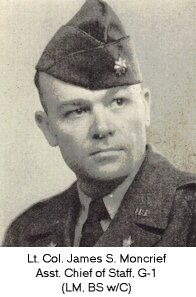 The
Assistant Chief of Staff, G-1, is responsible for matters pertaining to
the division's personnel and policies affecting it. He obtains trained
officer and enlisted replacements, directs their assignment to duties in
which they are of most value to the army, and arranges the return of personnel
discharged from hospitals.
The
Assistant Chief of Staff, G-1, is responsible for matters pertaining to
the division's personnel and policies affecting it. He obtains trained
officer and enlisted replacements, directs their assignment to duties in
which they are of most value to the army, and arranges the return of personnel
discharged from hospitals.
The evacuation of enemy prisoners of war and liberated Allied ex-prisoners of war is under the G-l's control.
Recommendations for decorations and promotions of officers and appointment of enlisted men to be officers and WO's are processed by the G-1, who makes recommendations to the General for approval or disapproval.
The G-1, through the Special Service Officer, supervises all special
service activity within the division. This includes Red Cross clubmobiles
and "doughnut dugouts", USO and movie showings and the athletic and recreational
programs. The appointment of general courts martial and knowledge of the
morale of the command, which includes knowledge of the number of men AWOL
and of the number of violations of orders serious enough to merit disciplinary
action, are G-1 matters.
G-2
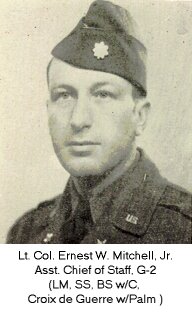 The
Assistant Chief of Staff, G-2, is responsible for the collection, evaluation,
interpretation and dissemination of all pertinent information about the
enemy and terrain. His is the task of gathering and weighing reports
from all sources to form a picture of the enemy's strength, his positions
and his capabilities.
The
Assistant Chief of Staff, G-2, is responsible for the collection, evaluation,
interpretation and dissemination of all pertinent information about the
enemy and terrain. His is the task of gathering and weighing reports
from all sources to form a picture of the enemy's strength, his positions
and his capabilities.
Vast amounts of information come from combat units through G-2's (intelligence officers), higher headquarters, adjacent units and attached intelligence teams such as Interrogation of Prisoners of War, Photo Interpretation, Order of Battle Counter Intelligence Corps, and Military Intelligence and' Interpretation. From prisoners, civilians, documents, photographs, radio, air and ground reconnaissance and from the G-2's own records come the bits of information which, pieced together, provide a picture of the enemy.
This information, together with estimates of enemy capabilities, is submitted to the Commanding General to aid him in forming his plans for a given operation. Reports on the enemy, his gun positions, everything which can be found out about him and the terrain, is made known to the combat units of the division to enable them to meet and defeat the enemy with a minimum loss of men. Counter intelligence, also, is the G-2's responsibility. He recommends and' supervises measures taken to limit the enemy's information of our troops.
The G-2 is also responsible for distribution of maps to division units
through the headquarters of the 25th Armored Engineer Battalion.
G-3
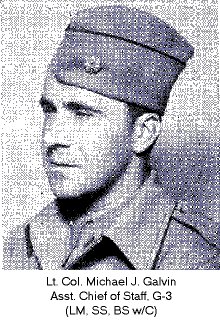 The Assistant
Chief of Staff, G-3, acts as an adviser to the Division Commander on matters
pertaining to operations during combat and on those of training when the
division is not in combat. The G-3 has three assistants, the Assistant
G-3, the Air Support Officer, and the G-3 Information-Education Officer.
Operations sergeants, draftsmen, stenographers and clerks comprise the
enlisted personnel of the
The Assistant
Chief of Staff, G-3, acts as an adviser to the Division Commander on matters
pertaining to operations during combat and on those of training when the
division is not in combat. The G-3 has three assistants, the Assistant
G-3, the Air Support Officer, and the G-3 Information-Education Officer.
Operations sergeants, draftsmen, stenographers and clerks comprise the
enlisted personnel of the
section.
During training periods the G-3 organizes and coordinates the training
of the division as prescribed by the Division Commander and higher headquarters.
This involves the issuance o f training directives, arranging for training
areas, training aids, schools, ranges and equipment with the object of
building the division personnel into a fighting team, in conjunction with
Division G-3's.
In time of combat the G-3 and his assistants plan and coordinate the
operations of the division in accordance with the desires of the Division
Commander and orders from higher headquarters. Fighter-bomber airplanes
are controlled through the Air Officer who works closely with the G-3 and
dispatches fighter support to units as needed. From the G-3 situation
map, kept current by information from the combat commands and units, the
Division Commander and the G-3 keep a constant check on the progress of
the operations,. making changes as dictated by the situation.
G-4
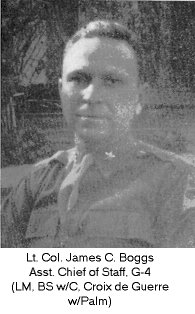 The Assistant
Chief of Staff, G-4, takes the plan of operations a outlined by the Commanding
General and estimates the requirements for supplies and equipment. In conjunction
with the other members of the General Staff, he works out such details
as the location of supply points, evacuation of prisoners of war, and the
road net to be cleared and maintained. The G-4 must then meet with the
Division's supply officers, such as the Division Quartermaster and
Division Ordnance Officer, to work out the many details to make the plan
effective. These are the officers who execute the plans that are madeby
the G-4, together with Battalion S-4's. When the Division had reached BREST,
it was 205 miles from the nearest Army dump, but it never went without
food, gasoline or ammunition because of careful planning and tireless efforts
of Division Trains and QM truck companies, coordinated by G-4. Also tied-in
with the G-4 ection was Engineer Supply, the Medical Battalion, traffic
control, Special Service Supplies, mail, salvage, and arranging for water
points. Higher headquarters must be contacted constantly to coordinate
plans and details. From the numerous reports received each day, a picture
of the supply status of the division is formed. From this picture the required
adjustments and changes must be decided upon by the G-4 and executed by
division supply officers. Reports are forwarded to higher headquarters
so that they may, in turn, have a picture of the supply status of the division
and make the necessary changes in their requirements and locations.
The Assistant
Chief of Staff, G-4, takes the plan of operations a outlined by the Commanding
General and estimates the requirements for supplies and equipment. In conjunction
with the other members of the General Staff, he works out such details
as the location of supply points, evacuation of prisoners of war, and the
road net to be cleared and maintained. The G-4 must then meet with the
Division's supply officers, such as the Division Quartermaster and
Division Ordnance Officer, to work out the many details to make the plan
effective. These are the officers who execute the plans that are madeby
the G-4, together with Battalion S-4's. When the Division had reached BREST,
it was 205 miles from the nearest Army dump, but it never went without
food, gasoline or ammunition because of careful planning and tireless efforts
of Division Trains and QM truck companies, coordinated by G-4. Also tied-in
with the G-4 ection was Engineer Supply, the Medical Battalion, traffic
control, Special Service Supplies, mail, salvage, and arranging for water
points. Higher headquarters must be contacted constantly to coordinate
plans and details. From the numerous reports received each day, a picture
of the supply status of the division is formed. From this picture the required
adjustments and changes must be decided upon by the G-4 and executed by
division supply officers. Reports are forwarded to higher headquarters
so that they may, in turn, have a picture of the supply status of the division
and make the necessary changes in their requirements and locations.